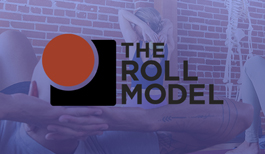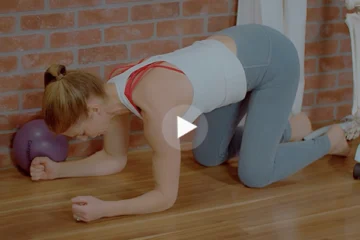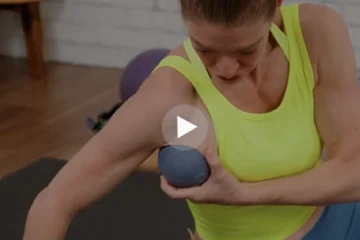
In Part 1 of this article, in addition to Megaplank and Raise the Chalice, I referred to Dolphin Supinate as being an excellent Yoga Tune Up® pose to activate and strengthen the serratus anterior muscle and stabilize the shoulder girdle. In the video below, Jill Miller discusses the necessity of external rotation of the shoulders in Downward Facing Dog and gives an excellent assessment tool to determine whether or not you should be doing that pose. As an alternative to Down Dog, she demonstrates Dolphin Supinate, which also happens to be a great pose to strengthen your serratus! Along with the importance of external rotation of the shoulders that she describes in the video, you can further support the shoulders by engaging serratus anterior. Just as in Megaplank, to contract the serratus in Dolphin Supinate, push the floor away with your forearms and then pull back with your forearms and hands to protract and depress the shoulder blades. Once you feel the action of serratus anterior working to nestle those shoulder blades into your upper back, be sure to find your Tadasana spine so that your upper back does not round. Remember that activating the serratus anterior is also a key element of shoulder stabilization in both Chatturanga and Downward Facing Dog.












Great at teaching the importance of ability of your own body to achieve a pose safely before continuing to do it poorly.
I am going to begin utilizing Dolphin Supinate in my classes to demonstrate the necessity of having the 180 degree supination of the forearms, and to begin strengthening the serratus anterior.
Thank you so much for this educational reminder about the importance of serratus anterior in all of these poses. It helps me to wrap my head around the shoulder joint and how we all differ.
Thank you Allison for sharing the Yoga Tune Up poses to strengthen serratus anterior. It’s hard to get at when students don’t know how to engage it. The video to determine if Down Dog is safe for a student is brilliant and to give them Dolphin Supinate as an alternative is very helpful.
Thanks to Lauren in the Kripalu YTU Level 1 Teacher Training for passing on info on this blog. The pose assessment is a gem and the Dolphin Supinate a great alternative to Down Dog.
I want to thank you Allison for your great article that brought me on my floor and on my yoga mat! I want to physically understand all the engagement of the serratus in the Megaplank and Supinate Dolphin poses. Wow ! Working !!
The video is a very very good complement. The verbal cues help me to be aware and apply the guidelines while preserving the health of the shoulder joint. Merci !!
When I start my yoga practice 3 years ago, the Downward Facing Dog was the position that almost all the teacher correct me. I ask so many time why, I try to understand that pose but I was in the cosmos. And I started to hate that pose. But in viewing this video and I reading this article and doing the pose with a partner, I understand more the activation of the muscles serrates anterior. And Adho Mukha Svanasana will be more a tool than a perfect and obligatory asana for me. Thank you Allison for your help.
Great information to help my students practice safely in their own bodies. I love Megaplank because of the learning to engage the serratus anterior in the pose. Dolphin Supinate really helps remind me to externally rotate. This article and video is a godsend to teachers on how to provide safe alternatives so that our students do not wreck havoc on their joints! Thank you for sharing.
It’s great to hear the science behind proper positioning and suitable alternatives for practitiioners who should not do Down Dog. I appreciate Allison’s article and the Jill Miller video demonstrating external rotation of shoulder and pronation of forearm to achieve position safe for shoulder joint. I also appreciate the many yoga teachers comments on what they see in their classes. Gives me a heads up as anew-ish teacher.
I love dolphin supinate and even add one block to help people get their shoulders to open and rotate externally. I think that once people undertstand why their shoulders need to be externally rotated they will look at down dog in a whole new way!
God point about the serratus being needed in this pose and clear explanation on how to activate it. I like dolphin suppinate already but will keep the serratus more in mind now, I could use some strengthening of that muscle!
Dolphin Supinate is now on my roster of poses to teach in place of downward dog. It’s amazing how many people come into downward dog when their body mechanics just don’t agree, much to the detriment of their shoulder girdle. Dolphin Supinate is the answer to keeping it challenging while working with what is accessible in your own body!
This video succinctly explains how important external rotation of the shoulder is essential for shoulder stability, especially if you are bearing weight in this joint. With recurring shoulder dislocations, Megaplank, Matador Circles, and Dolphin Plank are on my ‘must do’ list to regain shoulder stability and activate that serratus! Thanks for such an informative video and post 🙂
So excited to teach this in my class!!!! wowza!
I love the feeling of dolphin supinate and now prefer it over downward facing dog. I also received this adjustment from an assistant in one of my classes, and it definitely was internalized. Now when I come into dolphin supinate on my own, I can sense that gentle pressure on my wrists and the shoulders naturally want to rotate laterally. The power of human touch!
As a yoga teacher that teaches down dog in my classes over and over, I really feel like I now have a tool to help students with proper shoulder positioning. Understanding why down dog may not work for every body is something that every teacher should be clear about. Thanks for making it clear for me!
We worked with this concept today in Yoga TuneUp Level 1 Training and now I know why I have always felt that Dolphin with my palms up is so much more satisfying and feels more stable than down dog. Helping students focus on creating stability in their shoulders through external rotation is a wonderful goal. Thanks!
Thank you for including the video. I loved the easy assessment tool Jill gives of whether a body is ready to tackle Downward Dog. I can absolutely apply this with my students and private clients–so helpful! I also really like Dolphin Supinate as a strengthener. It’s accessible for many and super-strengthening.
Great assessment video and reminder of the importance of stabilizing our shoulders in external rotation.
We did these poses; Megaplank, Raise the Chalise, Dolphin Supinate and Downward dog, in the YTU master class today. I am always keen to learn alternatives and modifications for traditional yoga poses. I helped my mom, an avid yoga practioner, heal from a torn rotator cuff about 10 years ago, so I have long been aware of the fact that Downward Dog is not a pose for everyone.
Wow! How to get your students to not do down dog.. That seems challenging.
Thanks
Heather
Dolphin Supinate is actually a more advanced pose for classic yoga practice. you really have to work really hard on your external rotators( posterior fibers), infraspinatus, and teres minor while depress and protract your shoulder at the same time. By firing the serratus anterior, we will integrate shoulder muscle into our abdominal muscle.
[…] Dog? This way you learn to stabilize the shoulders, and build up your strength. Read an excellent YTU blog post to find out more! Share this:TwitterFacebookLike this:Like Loading… Posted in […]
I love Megaplank because of the learning to engage (while strengthening) the serratus anterior in the pose. It just didn’t click that I could also use Dolphin Supinate to strengthen the Serratus Anterior. As well, I have an easy time with externally rotating my shoulders in Down Dog but I actually prefer the pose Dolphin Supinate because it feels more challenging on my body, I now see this may be due to strengthening my serratus anterior.
This is wonderful information! I failed the test miserably. But failing the pronation test has other implications besides the inability to do the downward dog. I personally don’t care if I can”t ever do the Downward Dog, But this means I can’t type on a computer without destabilizing my shoulders (internally rotating them). This means I can’t sit in a movie theater with hands flat on the armrest without destabilizing my shoulders. This means I can’t play piano without destabilizing my shoulders. This means I can’t eat at the table without destabilizing my shoulders. This basically means that I cannot maintain a healthy posture during much of the day. What do I need to do in order to eventually be able to pronate my hands while keeping the shoulders externally rotated? Is there a video I can buy that would explain this, Jill Miller? I’m ready to buy.
What a great video on assessing a student’s pose and for teaching external rotation. I will remember external rotation puts the shoulders in the most stable position!
After seeing this DD test live in training last week I found it particularly relevant since a fellow trainee with a beautiful practice couldn’t fully pronate her forearm with her palm flat. As an instructor I can recommend students that do not pass this test to honor their body by practicing Dolphin Supinate as alternate pose but what about those that really enjoy their flow practice? Could proper activation of serratus anterior and the rotator cuff muscles give these students an opportunity to someday practice DD?
When you speak of stabilization of the shoulders, I realize now that stabilization was something that I neglected to pay attention to in the past. Luckily for me, after years of training,I managed to avoid major injury. However, viewing Jill’s description of potential shoulder-bicep-forearm injuries, I now see a possible link between my shoulder stability (or lack there of) and my re-occuring tendinitis.
On that note, Dolphin Supinate is a wonderful position in so many ways. I recently was instructed this position, and boy do I like it. Megaplank as well, another YTU technique that I have now adopted to my regular workout routine. A few weeks working on my serratus and it has helped me profoundly in all my balance poses.
Mega Plank has revolutionized the way way I both teach and do plank in my workouts! Rounding my back has always been a struggle to teach people (and myself) to avoid because sometimes you don’t realize you are doing it, but by cueing serratus…you avoid this all together and get awesome batman muscles!
AMAZING!! Great information to help myself and my students avoid shoulder injuries while practicing yoga. I did not know that the shoulder is most stable when it is externally rotated! I knew we should externally rotate it in downdog but I did not know why and the fact that some people just do not have that mobility – WOW. I love the simple test holding the elbow then rotating the radius and I am so pleased that I can offer dolphin supinate as an alternative for people who cannot rotate the forearm completely. Thank-you so much for sharing!!
It was really eye opening yesterday in training when I saw a guy who couldn’t internally rotate his arms to do the downward dog! It goes to show that every body is different. I’m excited to take what I’ve learn on my own practice and consciously see how every muscles moves. Down dog is not for everybody, good to know!
Down dog, not for every body. Ours shoulders are designed for mobility, not stability. The pronation of the forearm sets the shoulder up for the maximum external rotation available.
Love this video reminder of the YTU TT in April at Kripalu!! It is a tough one because teachers and students consider DD the “break pose” where you get to hang, breathe (e.g. Take 5 breaths in DD) and prepare for the next movement. And the more tired students get, the more they simply collapse in this pose and the shoulders severely internally rotate. I refuse now to let my students regard DD this way…and if they are in it for 3 or 5 breaths, we are activating everything in the pose….forget heels to floor!!! If they need to rest, I recommend child’s pose for a couple breaths. Problem is some students just don’t want to give DD up, regardless of what it will eventually do to their shoulders. There is a stigma attached…at least in their minds. So, yay for YTU to fire up and strengthen the serratus anterior and to also gain greater strength and flexibility to prepare for poses like DD. I can’t control what my students do when they leave my class, but giving them YTU poses will provide them awareness as they move into their next DD.
Recently while teaching I casually asked the class to come into Down Dog, then inquired where their main focus was in this posture. Unsurprisingly the answer was the ability to touch the floor with the heels. This led us to explore the above mentioned YTU poses and create a whole new way of experiencing the Down Dog Stretch focusing on safety and stability in shoulder alignment. Thanks for the tools Yoga Tune up
Down dog (and dolphin) may be the most misunderstood yoga posture. I think it may be exactly what you are citing – the serratus MUST be engaged to support tadasana spine. Great article.
Down dog is so over-used in a lot of classes. I really like this article and video. A lot of yoga teachers and practitioners would benefit from this quick and simple test. It would “save” a lot of shoulder problems.
Allison, great article!! I was one of the surprised trainees at the YTU TT this past week when “lo and behold” I am not a good candidate for DownDog, pushups, full planks, etc… Since I am not a Yoga based fitness trainer, this information will be utilized in other ways and I will spread shoulder health to other fitness circles! I am frequently on a computer for my work and knew that I was internally rotated but I hide it my overusing my rhomboids and excessively retracting when I am trying to correct external rotation. What an eye opener…. I am psyched to have this simple test in my toolbox. I LOVE the Doplphin Supinate and Angel Wings to fire up these weaker areas and get them trained.
Hey sister! I love this article and accompanying video because it is SOOOOO relevant to what I see all the time when sub teaching my group Yoga classes or starting a new private client. I wish I was able to say that I saw more proper shoulder stabilization but too often I see Yogis treat Down Dogs and Chaturangas as “pass through” poses rather than investigating them with the same diligence they might other asanas…and that’s how they end up with me doing Corrective Exercise! It’s especially shocking for most that they need to make adjustments to their Down Dog. Dropping into their internally rotated shoulders is often not what they had expected as one of the contributing factors to their dis-ease in the shoulder joint. I often hear that “it’s so much harder” to do while activating external rotation of the humerus. I’m so excited to add these YTU poses to my arsenal to make that sentiment a thing of the past!!! xo
Before my training with Jill, I had no idea some people where not candidates for DD. As vinyasa teachers we throw in so many DD’s, planks and chatarangas to our flow sequences with no idea we could be wrecking our student’s shoulders. Ladies and gents ignorance is not bliss. Especially as teachers we have to stand up for our students well-being and that involves always being at the cutting edge of bio-mecahnics. So glad I have learned this to better customize the yoga practice around my students needs.
Dolphin Supinate is such a helpful pose in figuring out if you are capable of doing downward dog with external rotation. Since downward dog is such a popular pose, everyone thinks they have the capability to do it. The forearm exercise is very helpful in assessing this. It is amazing to see that if you are not able to place your palm down fully and depress your shoulders, you are not a candidate for the pose. I liked Jill Miller’s example of creating tightness in the shoulders when typing on a key board if you are not able to internally rotate the forearms fully!